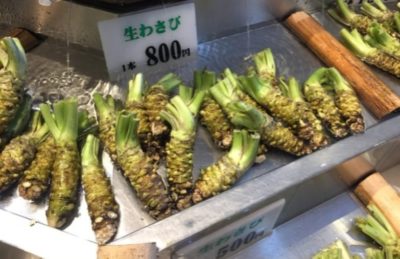Wasabi is a Japanese spice necessary to eat and enjoy Japanese cuisine, especially raw fish dishes like sashimi and sushi. In Japan, you can find tubes of wasabi in supermarkets and most Japanese households have a tube of wasabi in their fridge to use often. Nowadays, Japanese cuisine has become popular worldwide. So in some supermarkets, you can find tubes of wasabi in the Asian food product aisle. What is this green condiment made of? And why did Japanese people start using it?



Wasabi in the History of Japan
Wasabi was a wild plant like many other herbs. As it is a plant that has a pungent smell and stimulates the senses, it is assumed that it was once used as a medicinal plant. The word ‘wasabi’ was found in a 6th-century Japanese book. This is considered to be the oldest mention of wasabi in Japan. Historical documents show that in 1221, at the time of the emperor’s enthronement, wasabi was offered to the emperor. In the 14th century, wasabi became a spice to accompany dishes, consumed as it is now.
In the Edo period, the 1st Tokugawa shogun greatly appreciated the taste of wasabi. And because the leaf shape of wasabi resembles the coat of arms of the Tokugawa family, the Tokugawa shogunate put the wasabi culture under its protection.
The pungent taste of wasabi has a role in protecting food from rotting. So with the increase in the consumption of sushi and soba (buckwheat noodles) during the Edo period, wasabi became popular all over Japan. This is the time when wasabi consumption increased significantly.
How is the Root Used
It is the root of the wasabi grass that we create the wasabi paste from. The wasabi root is grated with a special grater. Compared to wasabi from a tube, the pungent taste of fresh wasabi is less pronounced and the flavor is better. As the wasabi root can only be kept for 2 to 3 weeks in the refrigerator, most people prefer to buy wasabi in a tube.
We can also eat the flowers, leaves, and stems of the wasabi plant. There are several recipes, and this is the simplest one. Cook the wasabi plant parts in boiling water and eat them with a little soy sauce. The flowers and leaves can also be eaten as tempura (fritter).
In wasabi farms and in the regions where wasabi culture is active, we can find many wasabi-derived foods. Examples are wasabi salt, wasabi ice cream, wasabi mayonnaise, wasabi pancakes, etc. If you are traveling in Japan, we advise you to try some wasabi treats!



Your Japan Tour
If you are thinking about making a trip to Japan, as seasoned Japan experts we can help you create your perfect Japan tour. Including expert guides who can add to your holiday with their extensive knowledge on topics such as local food and Japanese culture. Contact us to start planning your unforgettable holiday to this fascinating country full of once-in-a-lifetime experiences, culture, history, nature, and delicious food!

